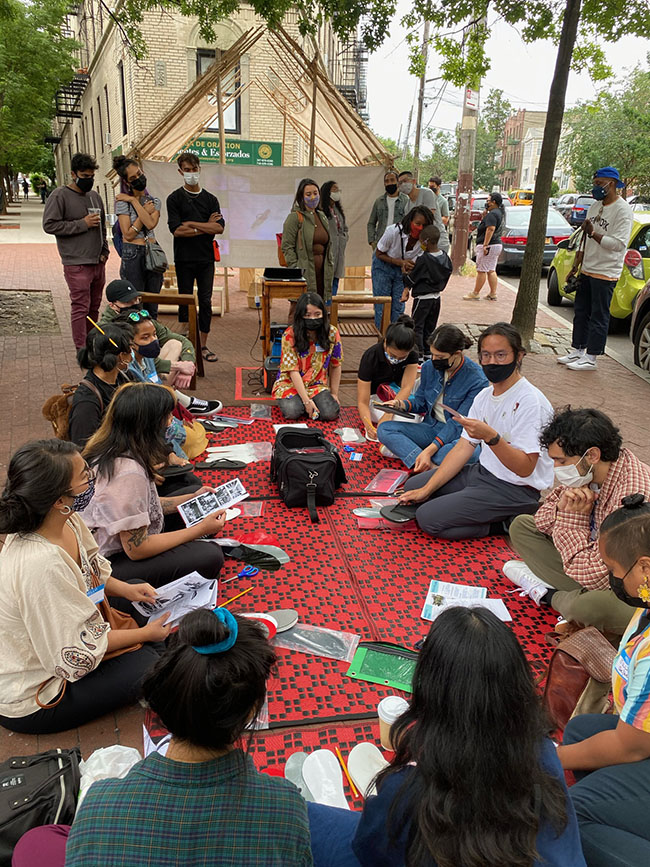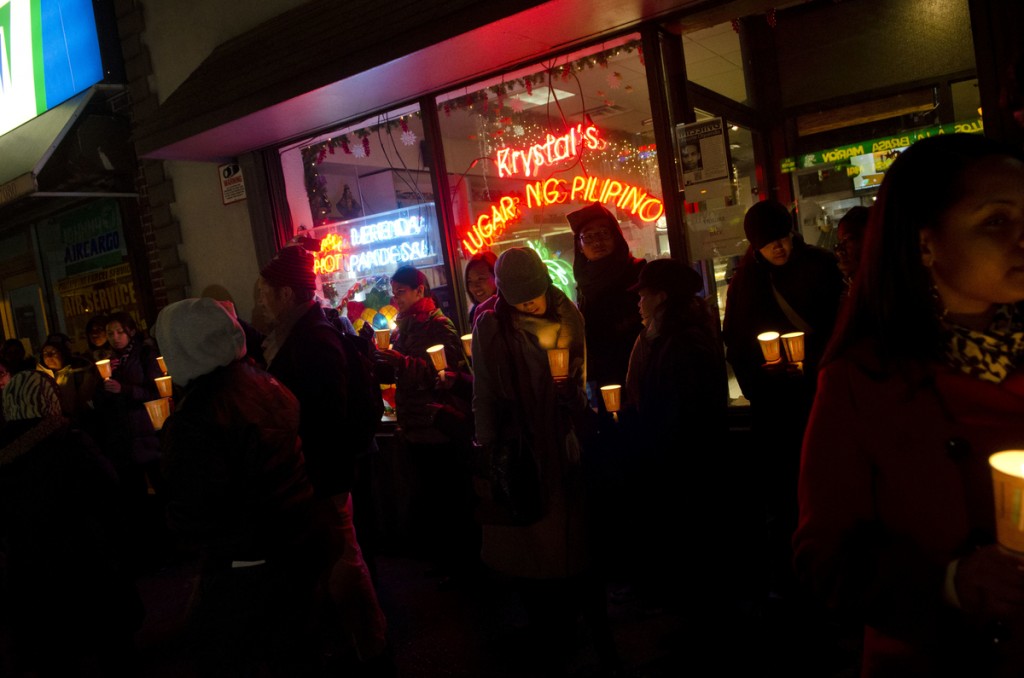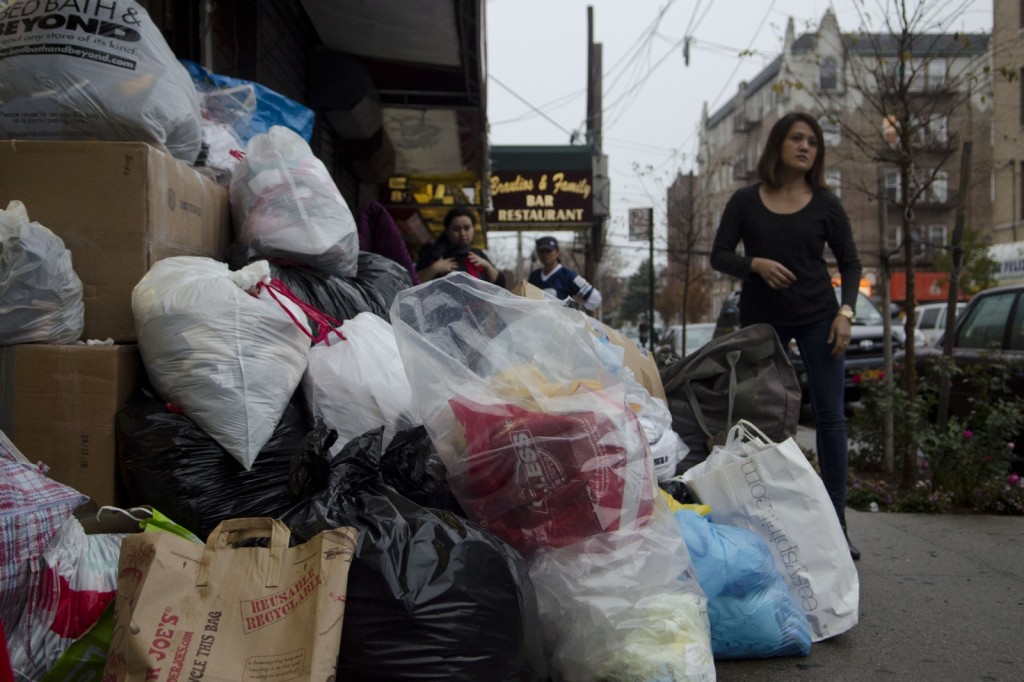A scene report takes a look at one burgeoning but endangered arts community in Queens

October 18, 2021
Woodside lives under the shadow of the 7 Train’s elevated tracks. Every four minutes, I’ll lean closer to the woman on the street selling taho just to hear her shout out the price. Everyone raises his or her voice to feel heard as the subway rumbles overhead. It’s the city’s attempt to disrupt a conversation.
One Saturday afternoon in June, old friends moved closer to one another and huddled in the triangle median along 69th Street and Roosevelt Avenue. Underneath a homemade construction of a bamboo house replicating a Filipino bahay kubo, or nipa hut, Karl Orozco debuted his outdoor art installation in collaboration with local arts organizations Little Manila Queens, The Laundromat Project, and Almasphere.
The artist greeted friends from around New York City and welcomed passersby along the avenue who were curious enough to stop and stare at the mass gathering of young creatives in masks, cut-out tank tops, and neon-colored hair.
I hugged my friend who I hadn’t seen since last summer, and adjusted my social bearings as I was introduced to a new person for the first time in months. I was then immediately greeted with a photo release form, a concept I hadn’t considered despite the year spent in front of a webcam, as video cameras circulated around the art installation.
The exhibit, Oras Na, which takes its name from a 1930s shoemakers union in the Philippines, features Orozco’s deconstruction of Air Jordan sneakers and its panels reconfigured into flip-flops, the artist’s commentary on Filipinos’ fondness for basketball and the crutch of American capitalism. The popular sneaker has garnered mass demand since its release in 1985 and graced the feet of basketball players and their fans worldwide. Orozco replicated the iconic design’s red, black, and white block panels onto tsinelas, or flip-flops, a representation of grassroots movements and power to the working people.

Little Manila Queens runs in the tradition of Fil Am arts organizations in Woodside working to have some government recognition. Woodside is a fitting space to invite and reunite the niche Filipino art and creative community. The nonprofit organization promotes the local Filipino-owned businesses along the strip of Roosevelt Avenue and has been advocating with the City Council to formally recognize the neighborhood along Roosevelt Avenue and 70th Street–with longstanding landmarks like the Fil-Am store and Johnny Air Cargo–as a designated Filipino community and to be known as Little Manila.
As I drive off the Grand Central Parkway onto the exit ramp onto Roosevelt Avenue, I am greeted by the evangelical church, 69 Bar, and El Pollo restaurant, long-running businesses in the majority Latino community. A group of young people hiked along the side streets in burgundy berets and their uniformed varsity jackets bearing the logo of the “Guardian Angels,” a local community policing group patrolling the quiet residential street.
Choreographer and dancer Paz Tanjuaquio arrived here more than 20 years ago to pursue her dance career. She found community at local Filipino American literary gatherings where she read texts that inspired the narratives of her choreography and movement. During the 90s, people were beginning to frequent Williamsburg for arts spaces and experimentation. Paz was interested in finding a space of her own for collaboration.
Her husband Todd Richmond found a raw warehouse in Woodside, formerly a button factory, with a for-sale sign. The couple acquired the space in October 2000 and named it Topaz Arts. “The beginnings of Topaz were a space for ourselves and other artists,” Paz recalls. They acquired nonprofit status and collaborated with multidisciplinary artists and performers.
“It feels the same as [20 years ago] because the pace slows down from Manhattan,” Paz says. The space is located in a residential area in the triangle between the crowded thoroughfare of Queens Boulevard and Roosevelt Avenue. In the beginning, neighbors asked what they intended on doing with the space. As time went on, Paz says that neighbors began to understand their artistic mission and eventually attended their gallery shows.
“Topaz was the only place dedicated to creativity and rehearsal space. If we don’t have rehearsal space, we’re screwed,” says Malini Srinivasan, a third-generation Bharatanatyam artist specializing in the South Indian classical dance form. Srinivasan met Paz and utilized the rehearsal space in Queens more than 10 years ago when she received a dance residency at the Queens Museum. “In Queens, we don’t have that many arts spaces and dance spaces. There are very few bookshops and green spaces outside of Flushing.”
“Topaz has been an anchor for arts and culture,” says Xenia Diente, founder of Little Manila Queens Bayanihan Arts. More arts and cultural spaces in Queens have closed down in the past few years, and maintaining a cultural atmosphere is almost a lost cause in a city dedicated to investing in developing higher-income neighborhoods.
Ged Merino understood the need for space and collaboration. He calls Bliss on Bliss Studio an “alternative space” where artists can meet in community with one another. The studio is a small gallery space around the corner and on the ground floor of a residential apartment building in Sunnyside, Queens. Merino, who says he faced criticism that the space wouldn’t last, has self-funded the space where he has showcased Filipino American artists and held screenings for more than 10 years. Arts spaces with similar communal values don’t always share the same fate.
The ceilings are low and its small rooms limit how far voices can travel. “It’s intimate,” Merino says of the humble gallery, “There’s a cross-cultural exchange and friendships forged among cultures.” He attributes the space’s longevity to the younger, emerging artists who support it. “In New York, a couple of bad shows and you’re done,” he says laughing. But over time, people started to meet each other and use Bliss on Bliss as a community space.
Artist Jeanne Jalandoni was invited to showcase her work as part of a group show, “Halo Halo NYC,” featuring artists, musicians and performance artists. Her piece from 2018, “Family Photo”, featured woven banana leaves, iron-on prints including a photo of the artist’s family, embroidery, on cotton and green canvas. “It was important for me to see artists making work that expressed other facets of their identities beyond their cultural makeup,” she wrote in an email.

The momentum to deliver a platform for this arts community led to the development of NExSE, an art collective for Filipino American artists in the Northeast. The group organized virtually in the beginning months of the pandemic. The small group of artists wanted to explore more avenues for working artists to show their work. After its pilot project in May 2021 at Bliss on Bliss Studio, NExSE exhibited at Princeton University with its show, “300 Years in a Convent, 50 in Hollywood.”
The members of NExSE want to bring in more artists into the fold. They’re out there. They need the resources and platforms. “In a way, it’s boiling and something’s ready. Hopefully at some point, we just need curators more familiar with Southeast Asian artists and Filipino American artists,” says artist and NExSE co-founder, Francis Estrada. “What’s missing is the scholarship.”
The Filipino American arts community has been “self-sustaining,” as Estrada calls it. Generations of Filipino American artists were carving out their own space. It has led to grassroots organizing and its punk nature.
The art installation organized by Little Manila Queens earlier this summer was a meetup for Fil-Am organizations around New York City, including the National Alliance for Filipino Concerns or NAFCon and the Pilipino American Unity for Progress or UniPro. Steven Raga, then a candidate for a City Council seat, got the signal for the event and showed up to shake hands with young potential voters. He would later lose the race.
As businesses begin to reopen, so do echoes of the threats of encroaching development in a more existential form, even as the locals are still reeling from the pandemic. The rezoning plan on 63rd Street has led some local shop owners to choose not to renew their leases. The economic situation has real impacts on the art community in the neighborhood.
In August, Queens Borough President Donovan Richards approved a plan for a 13-story complex along Roosevelt Avenue. The development would require a rezoning in order to construct over the nine-story limit. While the real estate developer led by EJ Stevens Group has pledged to dedicate affordable housing units and an arts space on the ground floor in accordance with rezoning requirements, it’s not enough. A performance/dance group, Mare Nostrum Elements, Inc., filed for a private rezoning application, together with Woodside 63 Management, to designate an arts space within the complex. Community members, however, remain skeptical of this plan.
A clear shift in demographics and capital in the borough has left struggling families and small businesses along Roosevelt Avenue wondering about the sustainability of living in Woodside. If Paz witnessed the mass move to Williamsburg for arts spaces 20 years ago, then the city has spiked its investment in affluent areas of Queens today.
Paz says that while the pandemic has strengthened solidarity, it has also exacerbated concern as a community. On that summer day in June, when we gathered at the median, it felt like nostalgia in the moment. The community organizations promoting social justice causes and awareness with flyers and representatives called out to the looming threat of what lies ahead. The neighborhood is rumbling and won’t back down, but is that enough?
In the same way that my friends and I hadn’t anticipated not seeing each other in a year and a half, we had no idea how long we would be standing in the Woodside that we saw that day. All around us, people were going about their day, moving from point A to B, and coping in the city that at times can deny them of their existence. Afterwards, my friends and I would disperse, back to our homes around the city.


